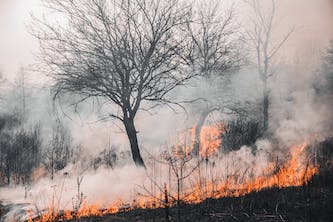A new study suggests that climate change could cause more lightning strikes in the forests of the northern hemisphere, which might lead to more wildfires. These forests are important for capturing carbon emissions and helping to slow down climate change. But when lightning starts fires in these forests, it releases carbon dioxide, making storms and lightning happen more often. While the number of fires worldwide has gone down in the last 20 years, heavily forested areas outside the tropics have seen a big increase in wildfires.
This year, Canada had a record-breaking fire season, with over 6,500 fires burning about 18 million hectares of forest and land. Smoke from these fires traveled to big cities in Canada and the US, and even all the way to Spain and Portugal. Most of the fires in the northern forests were started by lightning. A new map made using machine learning tools showed that 77% of the burned areas in these forests are because of lightning, unlike tropical regions where people starting fires is the main cause.
The study also predicts that the number of lightning strikes in intact northern forests could go up by 11-31% for every degree the Earth gets warmer, which could lead to more carbon emissions. These forests, often found in permafrost regions, are at risk because of the combination of a warmer, drier climate and more lightning strikes. While fires in tropical forests can be managed through education and intervention programs, stopping lightning fires is much harder.
The researchers say that we need to cut down on the gases that cause warming to stop more lightning strikes. They warn that the huge fire season in Canada should make us realize that we need to do something about the growing threat of wildfires in the world’s cooling forests. Even though it’s tough, experts believe we can still make a change and that forest fires should be a warning for us to act, not a reason to do nothing.
Original news source: Lightning fires threaten planet-cooling forests (BBC)
Listen
Slow
Normal
Fast
Group or Classroom Activities
Warm-up Activities:
– News Summary
Instructions: Divide students into groups of three. Each group is given a few minutes to discuss the article and summarize the main points in three sentences. Afterward, each group presents their summary to the class. The class discusses any differing details and clarifies key information.
– Opinion Spectrum
Instructions: Pose a statement related to the article such as “Cutting down on gases that cause global warming is the most effective way to prevent forest fires.” Students line up in a spectrum from “strongly agree” to “strongly disagree.” Students then take turns to explain their position, providing reasons for their opinion.
– Vocabulary Pictionary
Instructions: Write down key terms from the article (e.g., lightning strikes, carbon emissions, wildfires, permafrost, machine learning). Divide the class into two teams. Members from each team take turns drawing the terms on the board without speaking or writing any words, while their team guesses the term within a set time limit.
– Future Predictions
Instructions: Students work in pairs to discuss and write down their predictions on the future of forest wildfires if global warming continues at its current pace. They should consider the impact on wildlife, human life, and the global environment. Each pair then shares their predictions with another pair and discusses the similarities and differences in their views.
– Mind Map
Instructions: Ask students to create a mind map on a large piece of paper, starting with the phrase “Climate Change and Wildfires.” They should branch out into all the related topics mentioned in the article, such as “lightning strikes,” “carbon emissions,” “global warming,” and “forest management.” Encourage them to include any solutions or preventative measures discussed in the article. After completion, each group can present their mind map to the class.
Comprehension Questions:
1. What effect does climate change have on lightning strikes in the northern hemisphere forests according to the new study?
2. Why are the forests in the northern hemisphere significant in the fight against climate change?
3. What happens to carbon emissions when lightning starts fires in these forests?
4. How has the trend in wildfires changed over the past 20 years, and what is notable about the fires outside the tropics?
5. What record did Canada set this year regarding forest fires, and how far did the smoke from these fires travel?
6. According to the new map created with machine learning tools, what percentage of the burned areas in northern forests is due to lightning?
7. How much could the number of lightning strikes increase with each degree of warming, and what is the risk for forests in permafrost regions?
8. What do researchers suggest we need to do to prevent more lightning strikes, and what is their warning regarding the recent fires in Canada?
Go to answers ⇩
Listen and Fill in the Gaps:
A new study suggests that (1)______ (2)______ could cause more lightning strikes in the forests of the northern hemisphere, which might lead to more wildfires. These forests are important for capturing carbon emissions and helping to slow down climate change. But when lightning (3)______ fires in these forests, it releases carbon dioxide, making storms and lightning happen more often. While the number of fires worldwide has gone down in the last 20 (4)______, heavily forested areas outside the tropics have seen a big increase in wild(5)______.
This year, Canada had a record-breaking fire season, with over 6,500 fires burning about 18 million hectares of forest and land. Smoke from these fires traveled to big cities in Canada and the US, and even all the way to Spain and Portugal. Most of the fires in the northern (6)______ were started by (7)______. A new map made using machine (8)______ tools showed that 77% of the burned areas in these forests are because of lightning, unlike tropical (9)______ where people starting fires is the main cause.
The study also (10)______ that the number of lightning (11)______ in (12)______ northern forests could go up by 11-31% for every degree the Earth gets warmer, which could lead to more carbon emissions. These forests, often found in permafrost regions, are at risk because of the combination of a warmer, drier climate and more lightning strikes. While fires in tropical forests can be managed through education and intervention programs, stopping lightning fires is much harder.
The (13)______ say that we need to cut down on the gases that (14)______ warming to stop more lightning strikes. They warn that the huge fire season in Canada should make us realize that we need to do something about the growing threat of wildfires in the world’s cooling forests. Even though it’s (15)______, (16)______ believe we can still make a change and that forest fires should be a warning for us to act, not a reason to do nothing.
Go to answers ⇩
Discussion Questions:
Students can ask a partner these questions, or discuss them as a group.
1. What is climate change, and how do you think it affects our planet?
2. Have you ever experienced a wildfire or seen one on the news? How did it make you feel?
3. Why do you think forests are important for our environment?
4. Do you think wildfires are a natural part of forest life or a big problem? Why?
5. How would you feel if a wildfire happened close to where you live?
6. What do you think could be done to prevent wildfires caused by lightning?
7. Do you think technology like machine learning can help us understand wildfires better? Why or why not?
8. Why do you think people start fires in tropical regions?
9. What is your opinion on the fact that the number of fires has decreased worldwide but increased in heavily forested areas?
10. Do you think it’s surprising that smoke from fires can travel to faraway places? Why or why not?
11. How do you think we can cut down on gases that cause warming?
12. What is permafrost, and why do you think forests in permafrost regions are at risk?
13. Do you think it’s harder to stop fires caused by lightning than those caused by people? Why or why not?
14. Do you believe that we can still make a change to reduce the threat of wildfires? What makes you think that?
15. Why do you think forest fires should be a warning for us to act? What actions do you think we should take?
Individual Activities
Vocabulary Meanings:
Match each word to its meaning.
Words:
1. lightning
2. wildfires
3. forests
4. emissions
5. permafrost
6. intervention
7. threat
8. gases
Meanings:
(a) Something that could cause harm or danger
(b) Large areas covered with trees and plants
(c) Uncontrolled fires in natural areas like forests
(d) A sudden flash of light in the sky during a storm
(e) Substances like oxygen and carbon dioxide in the air
(f) Action taken to improve a situation
(g) Ground that is permanently frozen
(h) Substances released into the air, especially harmful ones
Go to answers ⇩
Multiple Choice Questions:
1. What is the main cause of wildfires in the heavily forested areas outside the tropics?
(a) Human activity
(b) Climate change
(c) Drought
(d) Lightning
2. How many fires burned in Canada during the record-breaking fire season?
(a) Over 6,500
(b) Over 10,000
(c) Over 5,000
(d) Over 8,000
3. What is the main reason for the increase in wildfires in the northern forests, according to the study?
(a) Deforestation
(b) Urbanization
(c) Pollution
(d) More lightning strikes
4. What percentage of the burned areas in the northern forests is caused by lightning?
(a) 50%
(b) 90%
(c) 77%
(d) 60%
5. What is the predicted increase in the number of lightning strikes in intact northern forests for every degree the Earth gets warmer?
(a) 5-10%
(b) 11-31%
(c) 40-50%
(d) 1-5%
6. How are fires in tropical forests different from fires in the northern forests?
(a) People starting fires is the main cause in tropical regions
(b) Lightning is the main cause in tropical regions
(c) Both a and b
(d) None of the above
7. What is the main challenge in stopping lightning fires in the northern forests?
(a) It’s easier to manage
(b) It’s much harder to manage
(c) It requires more resources
(d) It’s less destructive
8. What do the researchers suggest we need to do to stop more lightning strikes?
(a) Increase deforestation
(b) Build more cities in forested areas
(c) Cut down on the gases that cause warming
(d) None of the above
Go to answers ⇩
True or False Questions:
1. A new map showed that 77% of the burned areas in the northern forests are because of lightning, unlike tropical regions where people starting fires is the main cause.
2. The number of lightning strikes in intact northern forests could go up by 11-31% for every degree the Earth gets warmer, leading to more carbon emissions.
3. Lightning strikes in these forests do not release carbon dioxide, making storms and lightning happen less often.
4. The number of wildfires in heavily forested areas outside the tropics has increased in the last 20 years.
5. Smoke from the fires in Canada did not travel to big cities in Canada and the US, and even all the way to Spain and Portugal.
6. Climate change may not result in more lightning strikes in the forests of the northern hemisphere, causing fewer wildfires.
7. Canada had a record-breaking fire season this year, with over 6,500 fires burning about 18 million hectares of forest and land.
8. Forests in the northern hemisphere are insignificant in capturing carbon emissions and slowing down climate change.
Go to answers ⇩
Write a Summary:
Write a summary of this news article in two sentences.
Check your writing now with the best free AI for English writing!
Writing Questions:
Answer the following questions. Write as much as you can for each answer.
Check your answers with our free English writing assistant!
1. According to the article, how does climate change potentially affect lightning strikes in northern hemisphere forests?
2. Why are the forests in the northern hemisphere important in the context of climate change?
3. What has been the trend in the number of wildfires worldwide versus in heavily forested areas outside the tropics over the past 20 years?
4. How did the researchers use machine learning tools in their study, and what did they discover about wildfires in northern forests?
5. What do the researchers suggest we need to do to reduce the risk of wildfires caused by lightning strikes?
Answers
Comprehension Question Answers:
1. What effect does climate change have on lightning strikes in the northern hemisphere forests according to the new study?
Climate change could cause more lightning strikes in the forests of the northern hemisphere, which might lead to more wildfires.
2. Why are the forests in the northern hemisphere significant in the fight against climate change?
These forests are important because they capture carbon emissions, which helps to slow down climate change.
3. What happens to carbon emissions when lightning starts fires in these forests?
When lightning starts fires in these forests, it releases carbon dioxide, which can make storms and lightning happen more often.
4. How has the trend in wildfires changed over the past 20 years, and what is notable about the fires outside the tropics?
The number of fires worldwide has gone down in the last 20 years, but heavily forested areas outside the tropics have seen a big increase in wildfires.
5. What record did Canada set this year regarding forest fires, and how far did the smoke from these fires travel?
Canada had a record-breaking fire season with over 6,500 fires burning about 18 million hectares of forest and land. The smoke from these fires traveled to big cities in Canada and the US, and even all the way to Spain and Portugal.
6. According to the new map created with machine learning tools, what percentage of the burned areas in northern forests is due to lightning?
The new map showed that 77% of the burned areas in these forests are because of lightning.
7. How much could the number of lightning strikes increase with each degree of warming, and what is the risk for forests in permafrost regions?
The number of lightning strikes in intact northern forests could go up by 11-31% for every degree the Earth gets warmer, which could lead to more carbon emissions. These forests, especially in permafrost regions, are at risk because of the warmer, drier climate and more lightning strikes.
8. What do researchers suggest we need to do to prevent more lightning strikes, and what is their warning regarding the recent fires in Canada?
Researchers suggest we need to cut down on the gases that cause warming to prevent more lightning strikes. They warn that the huge fire season in Canada should make us realize that we need to do something about the growing threat of wildfires in the world’s cooling forests.
Go back to questions ⇧
Listen and Fill in the Gaps Answers:
(1) climate
(2) change
(3) starts
(4) years
(5) fires
(6) forests
(7) lightning
(8) learning
(9) regions
(10) predicts
(11) strikes
(12) intact
(13) researchers
(14) cause
(15) tough
(16) experts
Go back to questions ⇧
Vocabulary Meanings Answers:
1. lightning
Answer: (d) A sudden flash of light in the sky during a storm
2. wildfires
Answer: (c) Uncontrolled fires in natural areas like forests
3. forests
Answer: (b) Large areas covered with trees and plants
4. emissions
Answer: (h) Substances released into the air, especially harmful ones
5. permafrost
Answer: (g) Ground that is permanently frozen
6. intervention
Answer: (f) Action taken to improve a situation
7. threat
Answer: (a) Something that could cause harm or danger
8. gases
Answer: (e) Substances like oxygen and carbon dioxide in the air
Go back to questions ⇧
Multiple Choice Answers:
1. What is the main cause of wildfires in the heavily forested areas outside the tropics?
Answer: (d) Lightning
2. How many fires burned in Canada during the record-breaking fire season?
Answer: (a) Over 6,500
3. What is the main reason for the increase in wildfires in the northern forests, according to the study?
Answer: (d) More lightning strikes
4. What percentage of the burned areas in the northern forests is caused by lightning?
Answer: (c) 77%
5. What is the predicted increase in the number of lightning strikes in intact northern forests for every degree the Earth gets warmer?
Answer: (b) 11-31%
6. How are fires in tropical forests different from fires in the northern forests?
Answer: (a) People starting fires is the main cause in tropical regions
7. What is the main challenge in stopping lightning fires in the northern forests?
Answer: (b) It’s much harder to manage
8. What do the researchers suggest we need to do to stop more lightning strikes?
Answer: (c) Cut down on the gases that cause warming
Go back to questions ⇧
True or False Answers:
1. A new map showed that 77% of the burned areas in the northern forests are because of lightning, unlike tropical regions where people starting fires is the main cause. (Answer: True)
2. The number of lightning strikes in intact northern forests could go up by 11-31% for every degree the Earth gets warmer, leading to more carbon emissions. (Answer: True)
3. Lightning strikes in these forests do not release carbon dioxide, making storms and lightning happen less often. (Answer: False)
4. The number of wildfires in heavily forested areas outside the tropics has increased in the last 20 years. (Answer: True)
5. Smoke from the fires in Canada did not travel to big cities in Canada and the US, and even all the way to Spain and Portugal. (Answer: False)
6. Climate change may not result in more lightning strikes in the forests of the northern hemisphere, causing fewer wildfires. (Answer: False)
7. Canada had a record-breaking fire season this year, with over 6,500 fires burning about 18 million hectares of forest and land. (Answer: True)
8. Forests in the northern hemisphere are insignificant in capturing carbon emissions and slowing down climate change. (Answer: False)
Go back to questions ⇧













